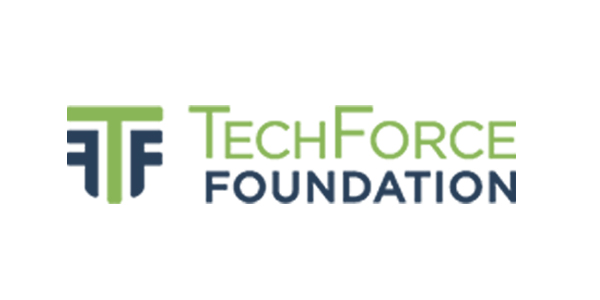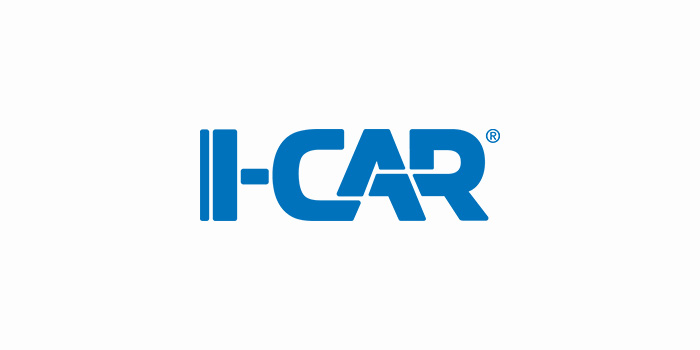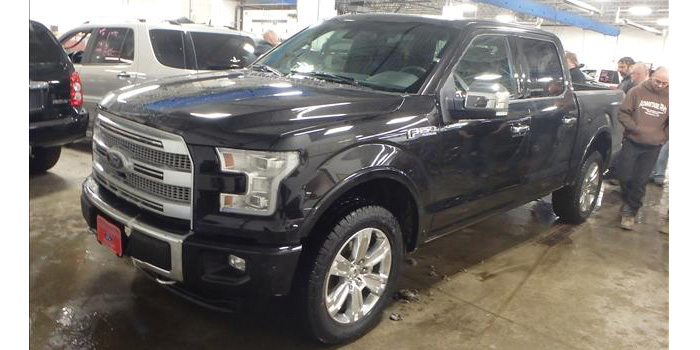 The 2015 Ford F-150 caused a lot of hype, worries, cost and pressure. Was it all worth it? I say yes. I have a shop and a technician who would probably agree.
The 2015 Ford F-150 caused a lot of hype, worries, cost and pressure. Was it all worth it? I say yes. I have a shop and a technician who would probably agree.
The shop and tech were well prepared for what they had to do. They had all the equipment and were ready to go. And surprise! The first damaged one came in the door. There were some minor glitches in the process as the electronics package surprised us a little, but overall everyone had a great experience. This led to a lot of confidence in the shop on new procedures.
Crash Goes the F-150
Recently, all of the expense and preparation we had to go through to be ready for the new F-150 was validated.
My employer spent a great deal of time and effort to be sure our company and technicians were ready for the challenge. We had all the equipment, and we did all the training and added training of our own to prepare our techs for the shift to aluminum in mainstream vehicles.
I don’t know if this 2015 Ford F-150 was the first collision-damaged one in the country, but I assume it had to be right up there. The owner bought his new truck and then got hit at the car wash after he left the dealership.
From the photos, you can tell the damage was fairly minor. The vehicle that hit his did not fare as well. Ford’s statement that this aluminum is strong was definitely proven in this situation.
Different, Not Difficult
I want to make sure everyone understands shops that are designated as aluminum repair facilities already know that aluminum repair is different, not difficult. The issue is that aluminum repairs are not as common as steel repairs. But repairing aluminum daily leads most technicians to be very proficient at the processes needed to do this.
A majority of shops don’t have the need or want to get into what was considered a specialty repair, but that’s rapidly changing. Ford is the first of many manufacturers that will be putting more aluminum in their cars.
No Resistance
Many technicians are a little nervous of the first repair they’ll be doing on aluminum, but with all the training and equipment being provided, I see that nervousness being minimized. In the issue of this F-150 repair, we had technicians volunteering to do the work. Figure that one out! I had one tech in a shop out of state who wanted to pay his own airfare to be the one to work on it.
One observation I made while conducting aluminum training with my own employer as well as other companies I work with is that techs were not resistant to training. In fact, many were excited to learn something new.
With the new equipment and tools to repair vehicles, we started seeing a trend. Technicians were asking to repair parts that are normally just replaced. Many wanted to try new equipment and skills. This leads me to believe most technicians want to improve and learn new things – contrary to what so many people seem to say about technicians not wanting to change. This new curiosity and desire to do something new is a great byproduct of the F-150.
One Nervous Customer
When the customer arrived, he was upset. Being a pickup owner myself, I felt his pain. I asked him some basic questions, and he said things like, “I love this pickup” and “It’s awesome.” The truck’s speed, power and fuel efficiency were great in his mind. The electronics and price were also appealing to him, but he was also nervous about having it repaired.
I showed him the prepped area and explained all the preparations made to work on aluminum. I showed him the equipment and assured him we were ready. He felt much better and saw the excitement as everyone came to see the pickup and the damage. I think he felt pretty special, but it won’t always be like that as these pickups become more popular.
The first thing to note is all the features and options available on this vehicle. The power tailgate and step were an awesome addition, and the electronics package was a surprise. There are features that were not talked about in training that change the repair of this vehicle. To avoid surprise and maintain cycle time, research into these systems on any vehicle is required.
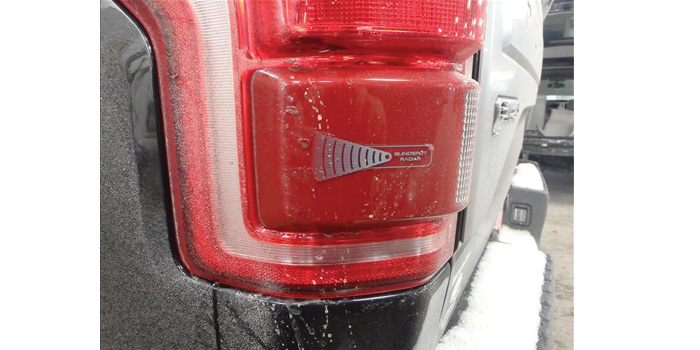
Be aware of recalibration procedures for all manufacturers. This vehicle suffered damage to the left front fender and driver’s door. The lower fender has a sensor that looks similar to the sensors currently used in bumper covers. This sensor, along with many others, makes up the Advanced Driver Assist System or ADAS. Learning all you can on this electronics package on all vehicles will save your shop some major headaches.
Repair Process
The repair process was pretty straightforward and followed all the training. The Ford procedures had been explained thoroughly, and the technician, Aaron, had no trouble, commenting that it was a common sense repair.
I will give you some of the tips Aaron shared. The pickup had the door and fender repaired versus replaced. The first thing he noticed was that the belt moldings and door lock combination were very easily removed and taped to the inside of the door, eliminating having to disconnect wires deep in the door. The damage from the collision on the door was shallow and was removed, but removing the damage or reforming the panel was more time-consuming than the same procedure on steel doors.
A concern on the door was a wave in the center, which was assumed to be collision damage. But when it was compared to the passenger front door, it was found to be similar, not the same. Upon removing the door panel, it was found that flutter foam was holding the skin in and causing the wave effect. Removing the foam on the intrusion beam and reapplying the foam cured the wave.
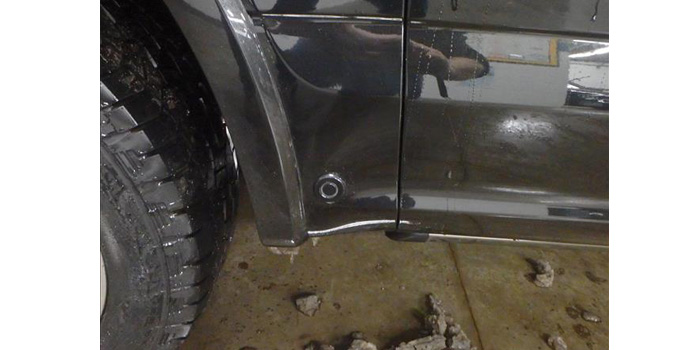
The fender damage was more difficult as the damage pushed lightly on the reinforcement in the corner, but bringing the reinforcement back corrected much of the damage. There was some thought and planning required, though, as to the adhesives in the area. Adjusting the fender was difficult due to NVH foam behind it between the body. The solution was to apply very low heat to soften the foam and allow adjustment. The foam solidified right back when cooled.
When the repair was completed, Aaron was pretty happy with the results and felt he had been very well prepped for the repairs. He was amazed at how Ford had made so many parts reusable and easy to work with.
Refinish Concerns
One concern with the refinish operation was the automatic running boards. The closeness and operation during refinish made them difficult to work with, and contamination of dirt and dust from the area concerned the painter. We all know you can wash and clean, but Murphy’s Law still applies. The best practice is to open the door and pull the fuse for the running board, which then locks in the down position to make masking easier.
The refinish operations are pretty straightforward and similar to steel. The difference was having to get the primer onto bare aluminum as soon as possible because oxidization of aluminum happens immediately. Priming quickly becomes a critical step to avoid adhesion problems, and it also helps to eliminate any possibility of cross contamination between steel and aluminum. These simple training guidelines can save a shop money and help it avoid dealing with a very unhappy customer.
Recalibration
Once all repairs were complete, a concern arose as to whether the ADAS would require recalibration due to the sensors having been removed. Our local mobile service scan guru came in and found that no lights were on but history codes were stored. This would never have been caught unless we had done a scan on the system. The shop manger decided it was better to be safe than sorry. Plus, our local scan tool service guy wanted to check this vehicle out, too. Let’s just say we didn’t have to twist his arm to come right out.
Do your homework on the electronics packages to see which vehicles need procedures done and which don’t. Even removing the taillight, which costs around $900 if broken or requires replacement, requires a scan tool to reset it. The radar logo on the lens identifies it as a sensor and a light. Check if the windshield and/or side mirror R&I or replacement qualifies for a recalibration, too.
Bring It On
So, as far as repairs go, the technician was happy with his training and tools and the shop was pleased that no real surprises or problems popped up with this pickup. Ford did our industry a very good service in preparing us and putting a lot of forethought into the repairs. I wish all of the automakers would do that. So, on behalf of the industry, all I have to say to the automakers is: “Bring on the aluminum!”










